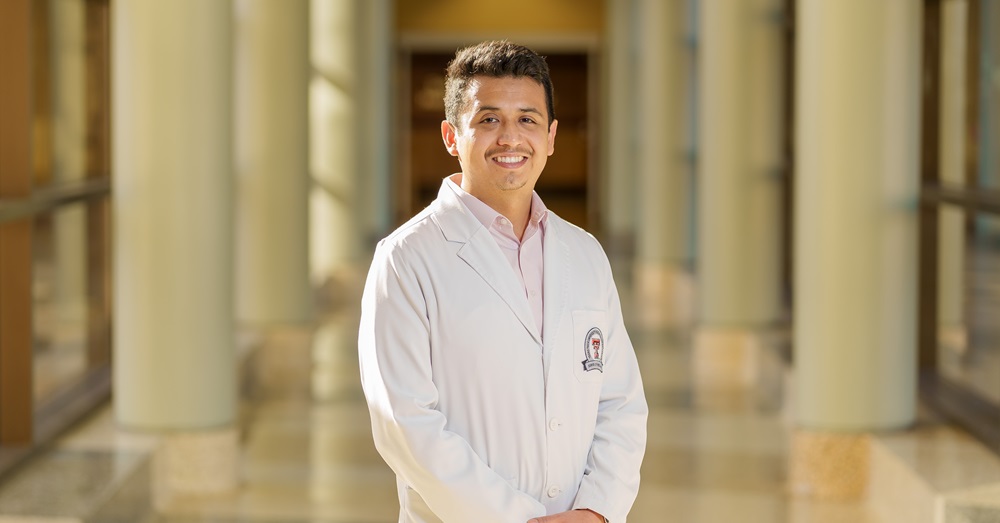TTUHSC Medical Student Part of NIH Research Team’s JAMA Publication

Luis Castro
When Luis Castro receives his dual M.D./MPH degree in May from the Texas Tech University Health Sciences Center (TTUHSC) School of Medicine and the TTUHSC Julia Jones Matthews School of Population and Public Health, he may reflect on the many experiences he shared with his classmates. He also will be able to recount an experience known to very few medical students: being part of a research team whose work was published by the Journal of the American Medical Association (JAMA), one of the most impactful peer-reviewed medical research journals in the world.
Castro, who hails from the Dallas suburb of Garland and is currently interviewing for a residency position in neurology, said the opportunity popped up last summer when he was completing a visiting student rotation at the National Institute of Neurological Disorders and Stroke at the National Institutes of Health (NIH) in Bethesda, Maryland.
“While I was there, I had the opportunity to work in a neurofibromatosis clinic where
patients from all over the country could enroll in clinical studies,” Castro recalled.
“One of the projects included a case report that was submitted to and accepted by
JAMA Neurology.”
The case report focused on a young patient with neurofibromatosis type 1 (NF1), a
disorder known to cause changes in skin coloring and tumor growth along nerves in
the skin, brain and other body areas. Castro said the patient came in with an unusual
presentation of the Harlequin sign and the underlying Horner syndrome. Harlequin syndrome
is marked by flushing in the face and upper torso. It often is associated with Horner
syndrome, a rare condition where the patient experiences upper eyelid drooping, constricted
pupils and loss of facial sweating caused by a disruption to the sympathetic nerve
supply.
“Essentially, the patient would experience flushing on half of their face while exercising outside in the summer heat,” Castro said. “Because her symptoms only occurred when she was outside in the summer heat, she presented a selfie photograph using her cellphone. This caused some initial confusion because her phone mirrored the image, which led us to believe the side of the problem was on the left side. In reality, she had an underlying tumor on the right side of her neck, which was later confirmed with magnetic resonance imaging. We were able to use a surgical scar present on the photograph as a landmark to help identify the correct side of the tumor.”
As technology’s role in patient care has increased, patients are increasingly able to provide such digital evidence of clinical symptoms. Castro said this is important for clinicians, particularly neurologists who rely heavily on lateralization of symptoms. An example of lateralization is when a patient experiences a condition such as weakness or paralysis on one side of the body.
“A goal of the article was to educate clinicians about the importance of understanding how some digital evidence can be mirrored by default in certain phones, but not others,” Castro explained. “As a result, we recommend patients raise their right hand when taking selfie photographs to help the clinician identify the side of the problem.”
Castro said having the opportunity to witness such an unusual presentation of an already relatively rare condition was one of the most academically interesting aspects of his NIH research experience, which also included the opportunity to co-author a book chapter on the surgical management of peripheral nerve sheath tumors. However, the most exciting part was knowing that his team’s work would be read by a wide audience and would continue the discussion on the expanding role of technology in the practice of medicine. He hopes the article will help clinicians investigate digital evidence more closely the next time a patient presents it in the clinical setting.
“I believe this experience has reinforced my desire to pursue academic medicine in the future,” Castro said. “Community neurologists play a very important role in taking care of our communities; however, I believe my professional reach can be exponentially larger in the academic setting by conducting research and helping educate the next generation of physicians.”
Related Stories
TTUHSC Cancer Researcher Honored by National Academy of Inventors
C. Patrick Reynolds, M.D., Ph.D., director of the School of Medicine Pediatric Cancer Research Center at TTUHSC, has dedicated his life as a researcher to developing treatments for childhood cancers.
TTUHSC’s Hudson Set to Serve as President for Society of Clinical Research Associates
The Society of Clinical Research Associates (SOCRA) has elected Texas Tech University Health Sciences Center’s (TTUHSC) Catherine Hudson, Dr.P.H., as its president for 2025-2026.
Clinical Research Institute a Source of Pride for Retiring Griswold
Upon his retirement, John Griswold, M.D., reflects on the Clinical Research Institute and what it has achieved.
Recent Stories
TTUHSC Cancer Researcher Honored by National Academy of Inventors
C. Patrick Reynolds, M.D., Ph.D., director of the School of Medicine Pediatric Cancer Research Center at TTUHSC, has dedicated his life as a researcher to developing treatments for childhood cancers.
TTUHSC School of Nursing Celebrates 10 Years of the Veteran to BSN Program
The TTUHSC School of Nursing recognized the 10-year anniversary of the Veteran to Bachelor of Science in Nursing (VBSN) program during the fall 2025 commencement ceremonies held Dec. 13 in Lubbock, Texas.
TTUHSC Dean to be Inducted into the National Academies of Practice as Distinguished Fellow
Gerard E. Carrino, Ph.D., MPH, dean of the TTUHSC Julia Jones Matthews School of Population and Public Health, will be inducted into the National Academies of Practice (NAP) as a Distinguished Fellow of the Public Health Academy.
